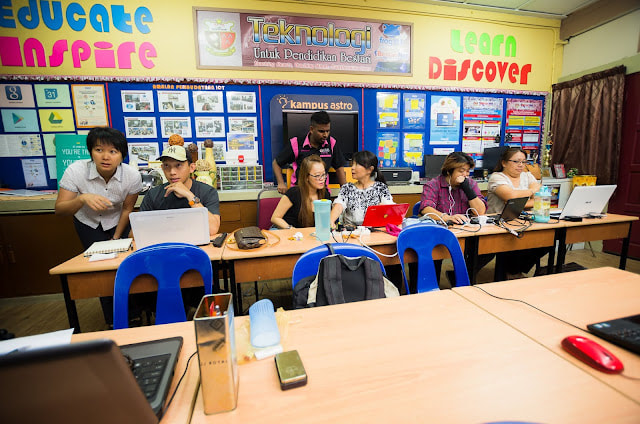|
(First published on beyondchalkandtalk[dot]com on 6th of March 2019)
The more you know, the more you know you don't know. ~Aristotle 13 years ago, I was a newly-minted ESL teacher in a beautiful primary school by the sea in Kunak, Sabah, Malaysia. I was young, enthusiastic and eager - but I was also naive, clueless and inexperienced. I couldn't wait to apply everything that I learned from my years of education at the teachers' training college in my classroom. I wanted to teach, I wanted to touch hearts, I wanted to change my students' lives. One of the areas that I'm super passionate about is technology integration in the language classroom. I'm not much of a tech-geek, but I do love experimenting with different types of tools and softwares to enhance pupils' engagement and increase their motivations to learn. But it was hard. Harder than I thought. Looking back, I think I managed to apply only a fraction of what I learned about technology integration and language learning from my pre-service training. My teacher education was of course useful; it provided the foundation that I needed to start off properly. But as an in-service teacher, I had to continue developing my craft by un-learning and re-learning a lot of things. I attended lots of teacher trainings, seminars, and conferences on educational technology. I learned from books, from the Internet, and from conversations with my colleagues. But most of all, I learned from experiences - through countless experiments, trials and errors, success and failures, fixes and mistakes. Throughout the years, I have formed my own belief system, my own principles, my own epistemology about educational technology and language pedagogy. I have developed my teacher knowledge on the subject. And this knowledge is not static. It is dynamic and ever-changing. My knowledge grows and evolves as I learn more things, and as I move from one school to another, from one context to another. But throughout the years, I have given very little thought on how all the knowledge that I acquired through the many professional development activities and self-directed learning that I engaged in were mobilised and transferred to my professional practice in the classroom. How can I best describe the construction of my teacher knowledge? What happened in the transition process, between the learning and the actual practice? Would understanding of the affordances and constraints of technology use in language teaching help me learn how I learn as a teacher, and thus inform me about the types of professional development best suited for me? I believe this is an area worthy of further reflections and explorations. Learning to Know, Knowing to Learn Teacher knowledge is a research area under the overarching field of teacher cognition. Borg (2003, 2005, 2015) defined teacher cognition as teachers thinking, knowledge and beliefs; and how they are related to practices in the classroom. The impetus for research on teacher cognition is the notion that teachers play an important role in determining what is going on in the classroom as active and thinking decision-makers (Borg, 2015). Borg also asserted that understanding of teacher cognition is central to the process of understanding teaching. The term 'teacher knowledge' emerged in the 1980's, especially through the seminal work of Shulman (1986) on pedagogical content knowledge (PCK). Shulman described PCK as "the blending of content and pedagogy into an understanding of how particular topics, problems, or issues are organised, represented, and adapted to the diverse interests and abilities of learners, and presented for instructions" (p. 8). According to Borg, Shulman's PCK had the largest impact on scholarships and research on teacher cognition, displacing the term 'teacher thinking' and remains the dominant concept today. Teacher Knowledge and Technology Integration One of the most recent contributions to the field of teacher knowledge is Mishra & Koehler’s (2006) technological pedagogical content knowledge (TPACK) framework, which was referred to as a “model of technology integration in teaching and learning” (p. 1029). The TPACK framework incorporates a technological knowledge domain into Shulman’s (1986) concept of PCK. It describes the interplay among knowledge of pedagogy, content and knowledge as crucial for meaningful technology integration in the classroom. Mishra & Koehler argued that technology, pedagogy, and content “exist in a state of dynamic equilibrium” and that productive technology integration needs to consider the three domains “not in isolation, but rather within the complex relationships in the system” (p. 1029). They proposed the adoption of the TPACK framework in restructuring professional development to help teachers develop “nuanced understandings” of the dynamic equilibrium among technology, pedagogy and content which is essential for meaningful technology integration in the classroom (p. 1030). According to Mishra & Koehler, the traditional methods of training for technology integration such as workshops and courses are no longer pertinent in helping teachers become “intelligent users of technology for pedagogy” (p. 1032). They listed factors such as “the rapid rate of technology change,” “inappropriate design of software,” “the situated nature of learning” and “an emphasis on what, not how” as the reasons why “competencies and checklists of things that teachers need to know is inherently problematic,” and therefore should no longer be applied in technology integration training for teachers (pp. 1032-1033). Mishra & Koehler advocated the ‘learning-technology-by-design’ approach which adopts the TPACK framework in technology integration professional development for teachers. This approach enables teachers to be engaged in “authentic design activities around education technology” which “compelled them to seriously study the complex relationships between technology and education” (p. 1038).
0 Comments
|
ArchivesCategories |


 RSS Feed
RSS Feed